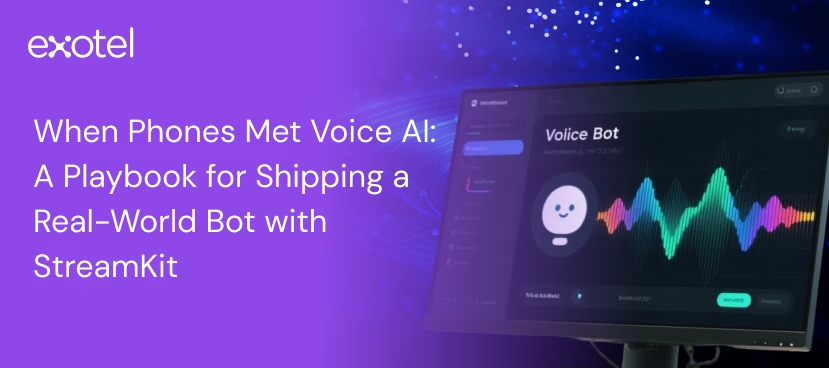On Monday morning, Neha—the head of CX—had one goal: put a real, production-class voice bot into her contact center. Not a lab demo. Not a one-off. Something her agents, supervisors, and customers would trust.
But every team saw the world through a keyhole. The infra team spoke in SIP trunks, NAT, SRTP, and PBX change windows. The AI team lived in WebSockets, STT/TTS, and bot endpoints. Each was right from their vantage point—yet the pieces didn’t click. If they waited for PBX upgrades, the go-live would slip. If they hacked together a bridge, reliability and compliance would suffer. Neha didn’t want another integration project; she wanted an outcome: faster greetings, higher containment, clean escalations, and full observability—without telephony surgery.
That’s exactly where Exotel’s StreamKit Cloud Connector fits: a managed SIP ↔ WSS (and SIP ↔ SIP) bridge that lets contact centers keep their existing PBX while lighting up enterprise-grade Voice AI—securely, instantly, compliantly.
By Friday, the CIO wanted numbers. The COO wanted relief. And Neha wanted one thing: a way to bring Voice AI into the phone journey without ripping up telephony or betting the farm on a single vendor.
That weekend, they tried something different: StreamKit Cloud Connector.
The first hour: connection, not surgery
There were no midnight maintenance windows, no new servers, no risky dial-plan edits. The team pointed their SIP INVITEs to StreamKit and registered the bot’s WSS endpoint. The next test call flowed PBX → StreamKit → Bot, and back again—in real time. Greetings landed faster. The audio felt consistent. The demo people kept postponing finally happened during business hours.
Behind the scenes, StreamKit bridged SIP ↔ WSS (and can handle SIP ↔ SIP), translating media both ways with enterprise-safe defaults: TLS/SRTP for transport security, Basic Auth for WSS auth, and India-hosted paths for data localization. No one had to become a protocol historian. The call just worked.
The first week: one bridge, many journeys
With calls flowing, the product owner asked the next question: could different callers route to different bots—IVR containment here, collections there, service journeys elsewhere—without multiplying integrations? They added simple headers to influence routing. Multi-bot policies kicked in: ANI-based rules for VIP service, campaign headers for collections, a fallback bot for after hours. StreamKit became a single, clean switchyard for every Voice AI experiment.
When a conversation needed a human, agent handover happened in well under a second. The customer never felt the seam. Agents received context and carried on. The same bridge also powered unidirectional streaming for live transcription and QA, and outbound bot campaigns for reminders and reactivation. One connector, many outcomes—without re-plumbing the PBX.
The first month: visibility beats guesswork
Before StreamKit, debugging felt like a scavenger hunt across systems. Now the team watched session events, Passthru metadata, and optional mono/stereo encrypted recordings in one place. They could see when the bot spoke, when the caller barged in, how long the handover took, and which campaign drove which outcome. MTTR dropped because the path became observable end-to-end.
Compliance became easier to answer. India PoPs, encrypted transport, and auditable trails turned long InfoSec debates into short checklists. The contact center didn’t need to change its DNA to pass an audit; the media path already respected it.
Features that mattered in the trenches
- Protocol Bridging (SIP ↔ WSS, SIP ↔ SIP): Works with Avaya, Genesys, Ameyo, and homegrown PBXs—and modern AIs like Dialogflow CX, OpenAI Realtime, Yellow.ai, Gupshup, AWS Lex, LiveKit, ElevenLabs, and more.
- Bidirectional & Unidirectional Streaming: Full conversations when you need them; lightweight streams for analytics/transcription when you don’t.
- Multi-Bot Routing: Route by headers, ANI, campaign, or line of business—without touching telephony foundations.
- Agent Assist & Escalation: Sub-500 ms handover keeps experiences seamless and context intact.
- Observability & Recording: Session metrics, Passthru events, and optional encrypted recordings for quality, coaching, and audits
- Security & Compliance: TLS/SRTP, Basic Auth-secured WSS, India-hosted media paths for localization and regulated workloads.
- Developer-Friendly: Clean REST surfaces—no manual trunk surgery, no Asterisk builds, no brittle middleware to babysit.
Benefits and advantages (why the story kept going)
Time-to-value, not toil. Move from PoC to pilot in days without PBX surgery.
Better experiences. Faster first media, fewer awkward silences, smarter containment, instant escalations.
Operational efficiency. Routine intents shift to bots; agents focus on real problems; leaders get a single pane of glass.
Compliance by design. India-hosted, encrypted, auditable—smoother reviews with Risk and IT.
Vendor freedom. A/B test or switch AIs without touching the telephony core.
The impact (what Neha showed the CIO and COO)
Every business is different, but patterns repeat:
- 20–40% reduction in handle time on IVR-addressable intents through conversational flows and faster greetings.
- 10–25% lift in first-contact resolution where bot plus instant escalation replaced rigid menus.
- 30–60% faster launches versus DIY bridges, with fewer late-night rollbacks.
- Meaningful cost avoidance by retiring one-off media gateways and consolidating on a managed connector.
- Higher compliance confidence from India-hosted media and auditable events.
The CFO didn’t just get a demo. They got a model.
Why teams choose StreamKit (and stay)
Because it’s the fastest safe path from phones to Voice AI.
Because it’s India-first on latency and localization.
Because it’s observable, not opaque.
Because it simplifies today and keeps tomorrow open—no AI lock-in, no telephony churn.
Because it’s built and operated by Exotel, trusted by thousands of enterprises running real, regulated workloads at scale.
Write your version of this story
If you’re modernizing IVR, launching agent assist, or standardizing Voice AI across lines of business, StreamKit turns “one day” into “Day 1”.
Your PBX stays put. Your teams move faster. The customer hears the difference.
For the how—APIs, flows, applets, and examples—head to docs.exotel.com
When you’re ready to size capacity or sketch a PoC, we’ll help turn the first test call into your next KPI win.




